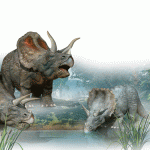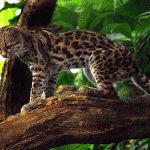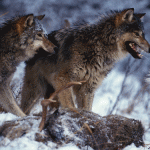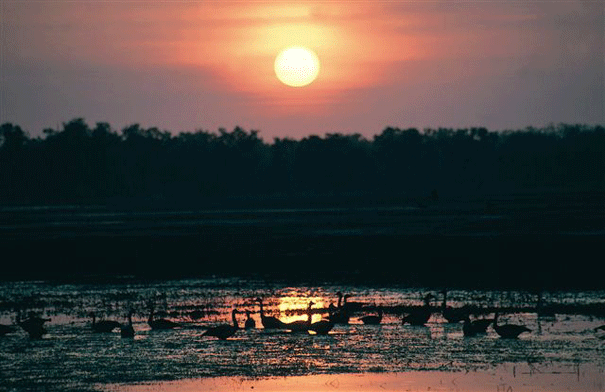
A spectacular Top End sunset. Image: Ecotours
In the Top End, you’re never really alone. The red dust and open roads speak of a uniquely Australian brand of isolation; but it only takes a moment’s pause to hear the roar of a thousand unseen voices, to see the low scrub wriggling with life.
More than one-third of Australia’s bird species can be found in Kakadu and, with more than 50 types of fish, over a hundred reptiles and amphibians and 60 species of mammals, not to mention tens of thousands of invertebrates, every centimetre of the bush is alive.
A few human companions won’t go astray, either. In the cloying humid climate, dehydration and sunstroke are never more than a few wrong turns away. Safety in numbers is important if you’re venturing far from town. Our small group is lead by Dean, who has been guiding groups around the staggeringly varied ecosystems of Kakadu National Park for more than a decade.
The journey begins at dawn, as we travel south-east out of Darwin in a bouncing Landrover. We head onto the Stuart Highway, rubbing sleep from our eyes while the city crawls into action behind us. The road extends right through the centre of Australia like an artery, roughly following the route mapped by its namesake, explorer John McDouall Stuart. Our intentions are not nearly so far-ranging and we stay with the highway only a short distance before exiting the turnoff at a place called Humpty Doo.
Here, we join the Arnhem Highway and make for our first stop, a placid wetland spilling off the Adelaide River. We’ve come in the wet season when it’s hot and humid, with the chance of gushing rain. Water spreads across the flood plains and fills rivers to overflowing, but for now, at least, the sky remains clear.
Croc country
Fogg Dam pegs the river in at one side with a semi-submerged wall, a relic of an attempt at rice farming long since abandoned in this region. The watery spill-off stretches out on either side as far as the eye can see. A forest of lilies covers the surface to the left. On the right, a menagerie of birdlife greets the gentle cascade of water with open mouths, hungry to catch their morning’s feed in the shallow runoff.
We drive along the wet dam wall and watch for beady eyes. Fogg Dam is currently home to a two-metre-long crocodile. His lurking presence keeps us confined to the car. It’s easy to see why a hungry croc would want to call this home. Little egrets and spoonbills cluster on the water’s edge, while flocks of plump magpie geese settle absently nearby. They’re easy pickings for river-dwelling salties who can wait patiently for hours for a docile, unsuspecting bird to wander within reach.
If the creature we’d been alerted to was present, he remained hidden by the deep murky water and grassy camouflage. An unseen croc is the most dangerous kind, Dean reminds us as we leave the dam. Fast but lazy, they rely on the element of surprise to attack their prey. As we head back to the highway, a brief pause to watch a sprightly Jacana hop effortlessly along the lily pads is a moment well spent.
A few hundred metres past the dam, we disembark to examine a school of ants midway through an epic leafy construction. This is bona fide bush tucker, we are told. To demonstrate, Dean pulls up an ant and gives it an experimental lick. The taste is “somewhere between a lemon and the top of a battery”, he explains. To our delight, a Leichhardt’s grasshopper makes a rare appearance. Only seenat this time of the year, the bright blue-and-orange insect heralds the wet season’s arrival with its presence.
We continue pressing east and spot another reminder of the Top End’s failed farming days. A herd of tame buffalo chews the morning away in a paddock near the road. Their numbers thrived after settlements were abandoned in 1949, and they bred to the point of causing an environmental hazard. Hunting and culling programs have dramatically reduced their numbers.
The days of farmers prodding the earth of the Top End for its agricultural potential are long gone. On the approach to Kakadu National Park, we pass vast hectares of mango orchards, busloads of tourists and a number of road trains carrying minerals quarried at nearby mining operations.
Our next stop, the town of Jabiru, has a turbulent history for such a small place. It’s the site of the now-defunct Ranger uranium mine, a battleground of controversy and protest reaching back to the 1980s, where the safety and environmental impact of its operation was fiercely debated.
A place for dreaming
On the map, the Top End juts out of Australia as if making its escape. It faces somewhat obliquely towards Indonesia’s scattered isles and it is from there the first indigenous Australians are said to have made their way south more than 50,000 years ago. Kakadu is largely owned by local Aboriginal tribes and leased to the National Parks Association for management.
The rich traditional culture is particularly evident in Kakadu’s stone country, a former wet season shelter for local tribes seeking higher ground for their paperbark camps. We visit the rocky outcrop of Nourlangie, where a collection of striking rock art and the stories it tells resonate strongly with the natural landscape. The depiction of Namarrgon, or lightning dreaming, in the Anbangbang outdoor rock gallery is both dramatic and poignant. It’s not hard to envisage the chalk-white spirit perched above his rock, conjuring the intense seasonal lightning storms that thunder across the valley. Minutes later we take a short walk up to Gunwarddewarde lookout to catch a glimpse of Namarrgon’s rock home jutting from the grey-green slopes on the horizon.
There are other subtle signs that Nourlangie was once a comfortable seasonal home to local the Aboriginal people. A series of dry caves would have offered plenty of cosy spaces for cooking and sleeping, while the papery bark of the Melaleuca tree could have been put to good use as a bed for weary hunters and their families. A diet of barramundi, bouncing macropods and crocodile would have been well supplemented by vegetables such as native yams and sweet treats like the wild passionfruit.
Next is a brief stop at Warradjan Cultural Centre for more dreamtime stories before bunking in at a nearby lodge for dinner. Some rambling brumbies saunter past, intent on finding their own evening meal.
The three o’clock storms Dean promised us earlier in the day are nowhere to be seen. Dinner is taken under the awning of an outdoor restaurant as we await the cool change. The heat of the day sent most of the morning’s menagerie scrambling for shelter, but as the sun descends below the horizon it is back in full force for a noisy encore. There’s no escaping the smaller buzzing insects. Even as we retreat to our rooms, they remain close by. Lumpy cane toads collect around a lamppost near the door of my room. I watch the ugly things and spot the pale, poisonous glands near their mouth. Few birds, snakes or crocodiles can snack on them and stay alive, although plenty have tried.
The next morning it’s time to set out on Yellow Waters Billabong for an early river cruise. We climb aboard a tinny runabout from a short pier. Little more than an hour past, we are told, a full-sized crocodile was lazing here in the sun.
As the dry season approaches and the water levels drop, spotting a three-metre reptilian becomes easier game. Salties collect in the main river systems en mass, swimming in the brackish water and blundering along the banks. In the wet, their world expands to a giant watery playground. You may not be able to see them, but you can be assured they are here.
Yellow Waters Billabong joins the tail end of the South Alligator River, the watering hole of choice for a staggering number of Top End inhabitants. The water is like glass as we cruise along it, its surface disturbed only by the ripples of our boat and an occasional spray of bubbles from below. A series of submerged handrails and wooden piers, like watery ghosts below the surface, can be seen beneath us. They highlight the sheer scale of water brought by the summer storms. In the dry season, these viewing platforms are perched high above muddy riverbanks, and boats such as ours are relegated to larger river systems.
Margaret, our river guide, points out a moving log barely visible above a car park now filled with several metres of water. It’s a crocodile, she assures us. Later, the zoom on my camera proves this to be true. In the absence of any close-ups, I turn my eyes skyward. The sheer range of birdlife in Kakadu is extraordinary. We pass itty-bitty rainforest kingfishers, their chests coloured with splashes of green, soaring sea eagles and a huge jabiru nest Margaret tells us was strong enough to survive the last serious cyclone that caused havoc across the area.
Back on solid ground, it’s time to leave Yellow Waters and head back out on the road. Singed patches of grass indicate the presence of spot fires, deliberately started by rangers to stimulate growth. To most city-dwelling Aussies, the practice of lighting a fire in the bush in the height of the summer is unthinkable. But, a combination of an excess of water, lack of wind and the unique properties of the vegetation make a rare exception here to the no-burn rule.
By midday, the humidity hangs off us like a cloak, and although the shaded pool of a watering hole tempts us with sweet relief, we hesitate. We are now far too aware of our reptile friends and their submerged hiding abilities. It takes some coaxing from tour guide Dean to get us in the water. He points out that the shallow streams and rock obstacles would deter a crocodile. “Plus,” he adds, “there’s no food for them here.” It’s too hot to point out that a group of pasty tourists would make a meal worth swimming upstream for.
Boulder Creek presents itself like a mirage, a waterfall spilling down one side. A few minutes in the water and all thoughts of predators are forgotten. Tiny frogs the size of thumbnails keep us company instead, hopping around on the grey rocks as we laze against them. We could stay here all day, but time is short and the road calls us back like a long-lost friend.
We have left Kakadu and are heading west again. A brief stop by the side of the highway reveals a black snake slipping out of our sights. Another lies like a rope on the roadside further ahead.
The best spot of the day comes later, where an anonymous strip of road finds two brolgas engaged in a duet. Watching these monogamous birds dance is enchanting. Year after year, the male woos his chosen female with a light, wing-beating hop.
Lake Bennett is our final stop of the day. A sensational sunset warms the sky as we retreat to well-kept cabins on the water’s edge. Out on the balcony, I hear a splash — one of my neighbours has cast a fishing rod out for a sneaky evening catch. Freshwater crocodiles reveal their presence with peeping red eyes, lurking for a catch of their own. As I climb into bed, I find a reminder that there is life here, everywhere. A clear-eyed, rubbery-looking yellow gecko perches high on the wall above me. I am too exhausted to protest at having to share my room with this harmless intruder, and the sound of it munching on a caught insect fades as I drift off to sleep.
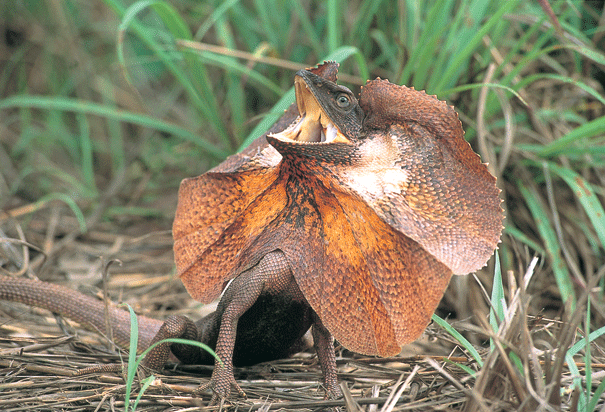
The frill-necked lizard is one of the many animals to be found in the Top End. Image: Ecotours
Spectacular falls
Morning takes us to Litchfield National Park, a popular day trip from Darwin all year round. The beautiful Florence Falls is not open to swimmers during the wet season but it is well worth making a diversion to view spectacular twin torrents flowing from the sandstone cliffs towering above. The swollen river floods the surrounding monsoon forest, leaving the spiky Pandanus spiralus trees knee-deep in water.
Also well worth a visit, if not for swimming, are the rugged arches of Tolmer Falls. A short walk will take you to a bank of viewing platforms set high on a rocky outcrop, from which the huge waterfall can be seen across the valley. Dark tunnels cut into the cliffs above the river are home to a rare colony of Orange Horseshoe Bats, and are protected from human invaders. A grassy flatland nearby is resplendent with a sprawling landscape of termite mounds. Cathedral mounds stand up to four metres high and look like glooping sand castles frozen solid. Equally impressive are the magnetic mounds, oriented north by observant insects who build with their backs to the sun. The Top End’s blazing weather can be trying and the constant swarm of insects is not for everyone, but I am secretly delighted by this wild place. There is something marvellous about its untamed presence, by the ever-present struggle between humans and nature.
Rolling thunder cracks as we make our way back to the city. Torrential rain buckets down with a violence that is spent less than half an hour later. By the time we return to the urban fringe, the roads are sodden but the sun has returned. Back in Darwin, I am dropped off at Moonshadow Villas, a tiny slice of tropical luxury. It’s easy to miss, perched outside the city centre near the Botanical Gardens. The rain shower and opulent living area are very welcoming. This time, the geckos stay outside the windows and I sleep better than I have in years.
By Rhiannon Elston.
This article was published in our March/April 2010 issue.


